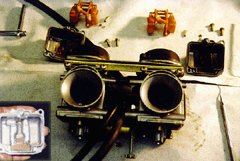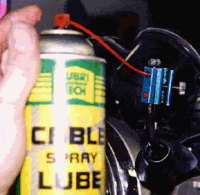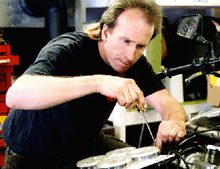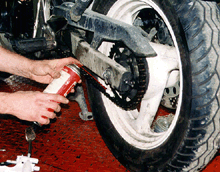|
WHY
DOES IT COST SO MUCH?
 |
| This
month's patient ... |
That is the question
every motorcycle owner utters when presented with the bill to get his
or her machine ready for the road come spring time. That of course is
only if that person did not properly prepare the bike for the long Canadian
winter. Now I realize that talking about storing your bike for winter
in July doesn't make much sense, but I have on numerous occasions tried
to educate the masses on the importance of proper winter storage. However
it would seem that my words of advice have been falling on deaf ears.
Well folks, so much for an ounce of prevention, here's the pound of
cure. It tastes awful but it works.
The Patient
A guy I know at
work was telling me how two years ago he never winterized his ride and
ended up paying a dealership in the GTA over $600.00 to get it up and
running again. The sad thing is he did the same thing again last Fall
with nearly the same result this Spring. The only difference is I told
him I'd have a look at it for less coin, as long as I could use him
in Sonic's Workshop as an example to others of what not to do. Deal
struck!!
So I picked up
his '92 Suzuki GS 500 from his house and trailered it to Sonic's Workshop.
Keep in mind that if the motorcycle has not been stored properly then
there is a very good chance that it will not start come Spring time.
If the bike won't go then you'll need a tow, and if you need a tow then
you'll need doe (hey, I'm a poet and didn't know it). The only thing
this fellow did prior to storage was to drain the oil out. He never
put any new stuff back in, just drained the old stuff out. (Bad). The
gas was also left in the carbs and the tank was only half filled. (Also
bad). To top it all, the battery was left in the machine and not attended
to for the entire winter. (I feel a severe beating is in order here).
High Voltage
... Not!
 |
| Gummed
up carbs need to be stripped and soaked. Insert at bottom left is
sediment found in the float bowl |
We have to start
somewhere, so let's go with the battery shall we? The battery on this
model is under the seat and is relatively easy to get at. With the battery
out and on the bench, a voltage test, followed by a specific gravity
test, was in order. Both failed miserably! To look on the bright side
I think it will probably survive with a good long time on the trickle
charger (as opposed to the fast blast on the 10 amp motorcycle battery
killer they call the quick charge).
The next step is
to drain out that stuff that used to be gas from the carburetors. Gas
that’s left in carburetors for long periods of time will evaporate,
leaving a varnish like substance on the jets and needles and a gooey
slime on the bottom of the float bowels. Of course, this does nothing
to aid the bike in the start up process.
As predicted the
fluid that drained from the left carb was a brown sediment filled liquid
that didn't much resemble gasoline. The right carb wouldn't even drain!
The only remedy for this little trauma is to pull the carburetors from
the bike, strip them down and clean them, thoroughly. (Add a couple
of hours to the bill for that one!).
 |
| Clutch
cable gets a good lubing. |
While removing the
gummed up carbs, I discovered that the choke cable was rather sticky.
I could pull the cable and activate the choke but the return spring
was not strong enough to return the choke back to it's resting position.
In most cases, but not all, copious amounts of cable lubricant will
rectify a sticking cable. This one was one of the 'not all' cases. No
matter how much lube was forced down that cables throat it just would
not free up. New cable time (read more $$$)!
The rest of the
cables, including the tach and speedo cables, were lubricated with high
temperature grease. The clutch and throttle cables had their free play
adjusted, as well as being lubed with an aerosol cable lube and cable
luber thingy.
As with many jobs
on a motorcycle, getting to the job itself is usually more work than
fixing the actual problem. Removing carburetors is a good example of
this and is usually a pain in the ass. You simply wouldn't believe how
much shit can be in the way, or how little space the manufactures have
allotted to perform this task.
Hats off to Suzuki
in this case, who allowed plenty of room to completely remove the air
box. With the air box out of the way there is then more than enough
room the pull the carbs back, up and out. Once out, both carburetors
must be stripped and the various metal parts soaked in a caustic cleaner.
After bath time is completed all the jets are then blown out with compressed
air and reassembled.
Valve Clearances
...
 |
Top:
Engine ready to access valves.
Bottom: GS500 shims. |
With
the carbs removed from the bike it is an ideal time to check those valve
clearances. Valve clearances have nothing to do with a failed winterization,
but they should be checked and adjusted, if need be, once a year. With
the carburetors out of the way, this job is suddenly so much easier.
The GS 500 utilizes
a shim over bucket adjusting system. That is a quarter size piece of
hardened steel, available in varying thicknesses. These are located
in 'buckets' that hold the shim and so prevent it from flying out at
redline (in theory anyway). The bucket itself is located between the
cams and the top of the valves.
The first step
of this process is to check each clearance to find out if they are to
spec, and if not, whether they need to be made bigger or smaller. Once
that is done you remove any non-to-spec shim from its holder and see
what size it is. The size of the shim will be stamped onto its face,
unless it was previously installed with the stamp mark facing up, in
which case the rubbing of the cam on the shim will have effectively
erased any discernible markings! With the size of the existing shims
determined (and the old clearance recorded) you can now calculate whether
you need a bigger or smaller shim size and exactly what size you will
need. (Sounds complicated, can be complicated and will cost more $$$).
 |
| Adjusting
carbs during balancing procedure. |
It's
very important to periodically check these clearances, as valve clearances
that are too tight will result in bad cylinder sealing, very poor performance
and potential valve burning (more $$$). Whereas clearances that are
too large will result in a noisy top end, which can lead to premature
wear, as well as reduced performance. This GS had only two clearances
that were too tight, which were easily swapped for a couple of skinnier
ones.
With the clearances
out of the way, the carbs and air box (along with a new air filter -
more $$$) can then be reinstalled. Next step is some new oil and a fresh
oil filter. Toss in a set of new spark plugs for good measure, and the
engine is all ready for a summer of happy motoring.
It's all a matter
of balance ...
 |
Top:
Carbs badly out of balance
Bottom: After adjustment. |
With
the motor all happy we can now balance those newly cleaned carburetors.
Balancing ensures
both cylinders are getting exactly the same amount of fuel and air.
If the carbs are not properly balanced or sync'd, one cylinder ends
up doing all the work while the other one is just along for the ride
- as proved to be the case with this GS. With carbs this far out of
sync, (see picture both gauge readings should be close to each other)
the engine will not perform well and also tend to sound like crap (especially
at idle).
Using vacuum gauges
(hooked up to the inlet manifolds) makes this a very easy job. It's
a matter of simply adjusting the balance screw (located between the
carbs) until both gauges are reading the same. This is not a big job
so long as you have the correct tools and ensure that the valve clearances
have been checked first and are to spec. Valve clearances that are not
set properly will result in inaccurate gauge readings.
The heart is
good. The chassis needs work ...
 |
| Correct
location for lubing the chain. |
With the engine
running nicely I can now start to work on the rest of the bike. We want
it to be just as happy, more fun to ride and safer to boot.
Over the winter
(and through the summer for that matter), tire pressures will drop approximately
10% every month. The tires on the GS were at a unhealthy 5 P.S.I. on
the front and 8 P.S.I. On the rear. This was corrected to 32 P.S.I.
On both. The drive chain was the next port of call on this spring time
tour of the world of two wheels. The chain, which needs constant attention
throughout the year, was a dried out rusty thing that was suffering
from a bad case of maladjustment. Fortunately ample chain lube and some
fine adjustments made the world of difference. The worst case scenario
would have been to replace the chain, in which case add another $100.00
plus to the final bill.
Continuing on with
the survey it was discovered that the brake fluid was in desperate need
of replacement. Brake fluid is a clear fluid that slowly turns dark
with age. The stuff in the master cylinders on both the front and rear
cylinders were now a dark brown. Even worse than that was the condition
of the front brake pads. Upon inspection, the pads were found to be
worn right down to the steel backing! Once again the motorcycle Gods
must have been smiling, (trust me it doesn't happen very often) because
the disc was not damaged! Very lucky, because damaged discs would have
added another $300-$400 onto the bill.
Wash, wax, gas
and ride ...
 |
Left:
New brake pad
Right: Buggered brake pad. |
Well that seems
to be about it. Let's see; the cables are lubricated, the carbs are
cleaned and balanced, valve clearances are all happy, oil and filters
are done, tires have air, brakes have new fluid and there are new pads
on the front. The battery has been topped up and charged, clutch and
throttle free play is now correct, there are two new spark plugs in
the cylinder head, the drive chain is all slippery and properly adjusted,
and the charging rate has been checked and passed. All that's left to
do is a wash, wax, gas and ride. Oh yes ... and pay the bill.
Here's a rough
break down of the costs:
| Oil
Filter |
$6.00 |
| Air
Filter |
$19.00 |
| Oil |
$10.00 |
| Shims |
$16.00 |
| Choke
Cable |
$35.00 |
| Brake
Pads |
$26.00 |
| Brake
Fluid |
$12.00 |
| Pick-Up
(Tow) |
$50.00 |
| Labour
(4 Hours) |
$180.00 |
| Total |
$354.00 |
| Total
with Tax |
$407.10 |
Hopefully that
has put the fear of spending lots of unnecessary cash into you. Winterisation
is a lot cheaper, trust me.
Thanks for reading,
Sonic.
|